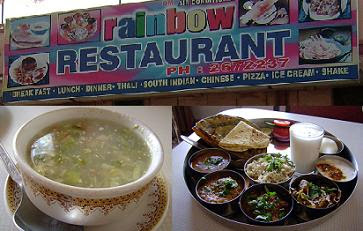The Hawa Mahal, which adjoins the famous City Palace wall, was built in 1799 by Maharaja Sawai Pratap Singh and has now become one of the major landmarks of Jaipur. The palace is shaped like a pyramid and is a five-storied building, with number of small windows and screens, with arched roofs. There is intricate carving in the front and much attention has been paid to even minute details yet the backside is more a mass of pillars and passages. Its purpose was simply to allow the royal women a view of ceremonial processions while seated behind the small windows, allowing them to look out without themselves being seen.

1012HR Amber Fort
Amber is located at a distance of 11 km from Jaipur and was the old fort of the Kachhwaha of Amber, which used to be the capital, till it was moved to Jaipur. The construction of the Amber Fort began in 1592 and was started by Man Singh I. The exterior of the Fort is not in the least like its interiors. The outside very imposing and rugged looking whereas the inside is a comforting and warm interior which is influenced by the Hindu and Muslim style of ornamentation. On the walls, are paintings depicting various hunting scenes, and there is also a lot of work on walls, which are covered with intricate carving, mosaic and minute mirror work that make the halls look very majestic and imperial. The fort is built with white marble and red sandstone and looked even more attractive because of the Maota Lake in the foreground.




1059HR Amber Fort - Ganesh Pole
A fine portal covered with paintings was built by Sawai Jai Singh. This gateway provides access to the inner court in which the principal apartments of the king are situated and where in everything from roof to floor is to be seen in marble. The top of the gateway is mounted by a pavilion called Sohag Mandir through whose latticed windows the royal ladies watched ceremonial functions held in the Diwan-I-Am.






1228HR Jaigarh Fort
An eye opener to the lovers of forts in India and abroad the Jaigarh Fort stands at a height of 602m above mean sea level. It stretches 3km in length from North to South and 1km in width from East to West. The periphery walls of the fort stretch out covering almost the whole hilly region. To guard these periphery walls from any trespass, there were 27 chowkies or check posts covering the whole region with guards posted at each.
The Jaigarh Fort is 15km from Jaipur City and 1.5km from Amber Palace.


1241HR Jaigarh Fort - Jaivana
The highlight of the Jaigarh Fort is definitely the Jaivana, which is the world’s largest cannon on wheels. It was built in Jaigarh’s foundry in year 1720. Many say that the cannon was only used once and the ball fell some 35kms away on a village. But that’s quite doubtful, since a closer inspection of the cannon actually revealed that it has been fired at least a couple of times.


1316HR Jaigarh Fort - Temple


1327HR Jaigarh Fort - Subhat Niwas

1329HR Lakshmi Vilasa
The most beautiful building in Jaigarh Fort, the Royal Palace Hall of Lakshmi Vilas reflects the architectural taste of the then rulers of Amber. Lakshmi Vilas has a provision of putting cotton stuffed curtains to make the hall air tight to keep it warm. The hall allows a free access to the breeze during summers when the windows are opened and the curtains lifted up. Lakshmi Vilas was built by Mirza Raja Jai Singh (1621-1667) with certain additions and alterations taking place during the reigns of Sawai Jai Singh II (1700-1743) and Sawai Ram Singh II (1835-1880).
Architect Vidhyadhar was awarded a “Siropao” (robe of honour) for the additions done in the palace complex. Maharaja Ram Singh II added the tin shed in front of the hall.

Jaigarh Fort is BIG!

The drilling complex of the cannon foundry at Jaigarh, is a mechanical device. Providing an insight into the technical advancement and science of military warfare, the drilling complex was used for drilling bores in the barrels of the cannons. The complex consists of an octagonal room having a height of 31ft which has four wooden bars revolved by four pairs of oxen. The gear system lying below this room consists of four wheels. When the cross bars rotate this made the giant wheel below to rotate. In turn three other wheels rotated. The fourth wheel which opens in the drilling complex has a frame or a socket and screw system. Different cutters were fitted in the socket thus making bores into the barrel. The largest cutter available in Jaigarh is 15ft in length and the smallest being 7.5ft. As cannon making was a guarded secret, the Maharaja witnessed the process from the double storey balcony. In the temple of Ganesha, rituals were performed before commencement of work.

1406HR heehee spotted a monkey eating ice-cream when leaving Jaigarh Fort

1406HR heehee spotted a monkey eating ice-cream when leaving Jaigarh Fort
The City Palace or Chandra Mahal is in the center of Jaipur and covers 1/7th or 15% of the Pink City’s area. Jai Singh built it between 1729 and 1732. A high wall within which are a series of courtyards, gardens and other buildings surrounds the palace. Successive rulers have made additions to the existing complex. Some of the maharajas filled the palace with scientific and artistic treasures, while others focused on public works. The palace is now a museum.
Mubarak Mahal is the first building seen inside the palace. It was built by Maharaja Madho Singh around 1900 for his guests. Its exterior is adorned with minutely carved lace like marble work for which the city is justly renowned. In this beautiful edifice, we have an exceedingly delightful example of Hindu architecture embellished with artistically carved screens, balconies, arches and brackets. It now houses the Textiles and Costumes Museum. It has some rare specimen of Rajasthani and India Textiles and Costumes.




Birla Mandir or the Lakshmi-Narayan Temple, situated just below the Moti Dungari. This is a modern temple built of white marble on top of a hill, dominating the skyline of south Jaipur. The Birlas (industrialists who have also built several temples in India) built this temple. The temple has been constructed in white marble and has three domes, each portraying the different approaches to religion. The presiding deities here are Vishnu (one of the Hindu Trilogy Gods) called Narayan and his consort Lakshmi Goddess of wealth and good fortune. The temple is built in white marble and exterior has carved sculptures of various mythological themes and images of saints. The interior has large panel in marble of mythological proceedings. The images of the deities are placed in the sanctum sanctorum. Built on raised ground, it is surrounded by large lush green gardens.













No comments:
Post a Comment